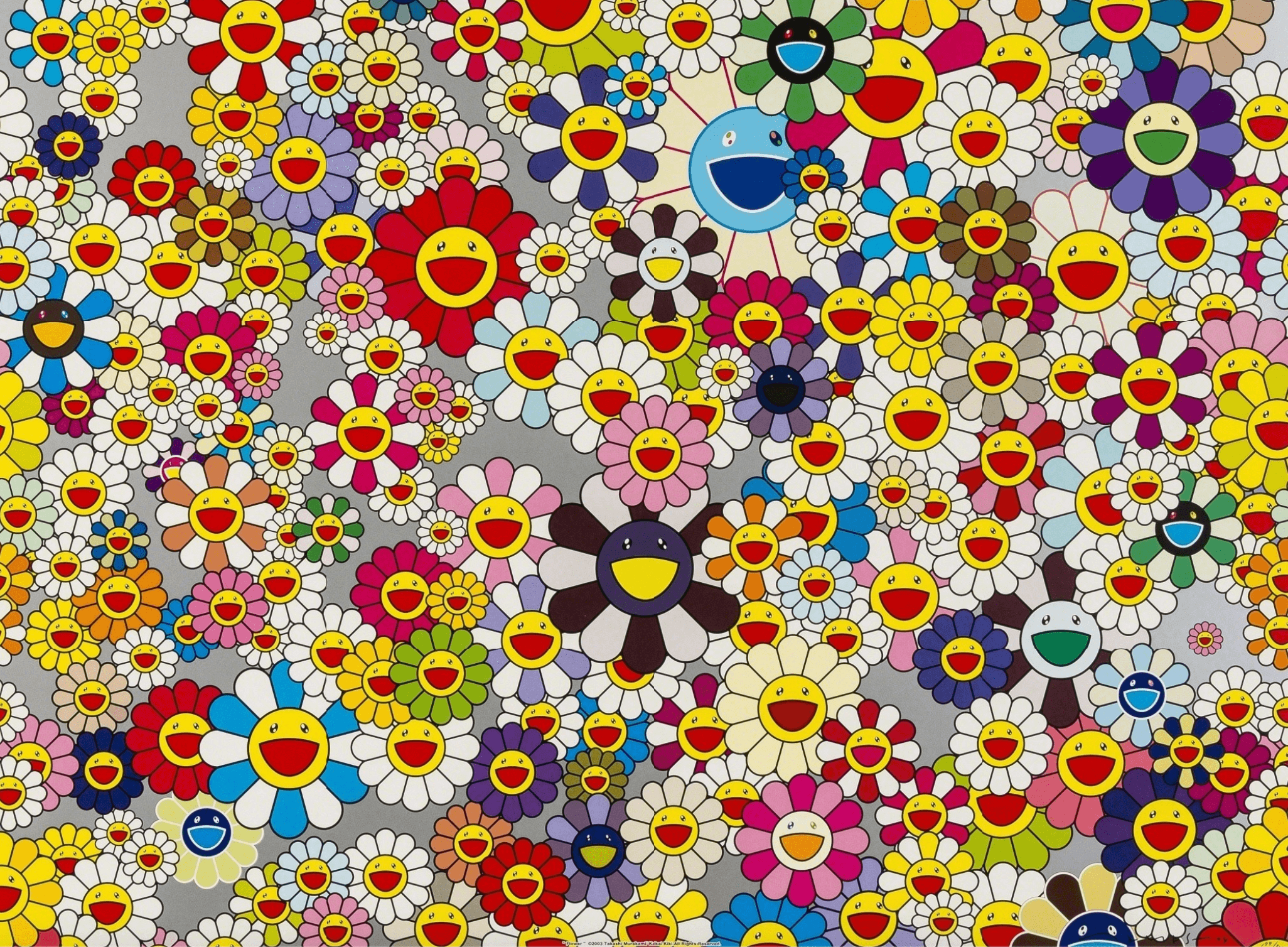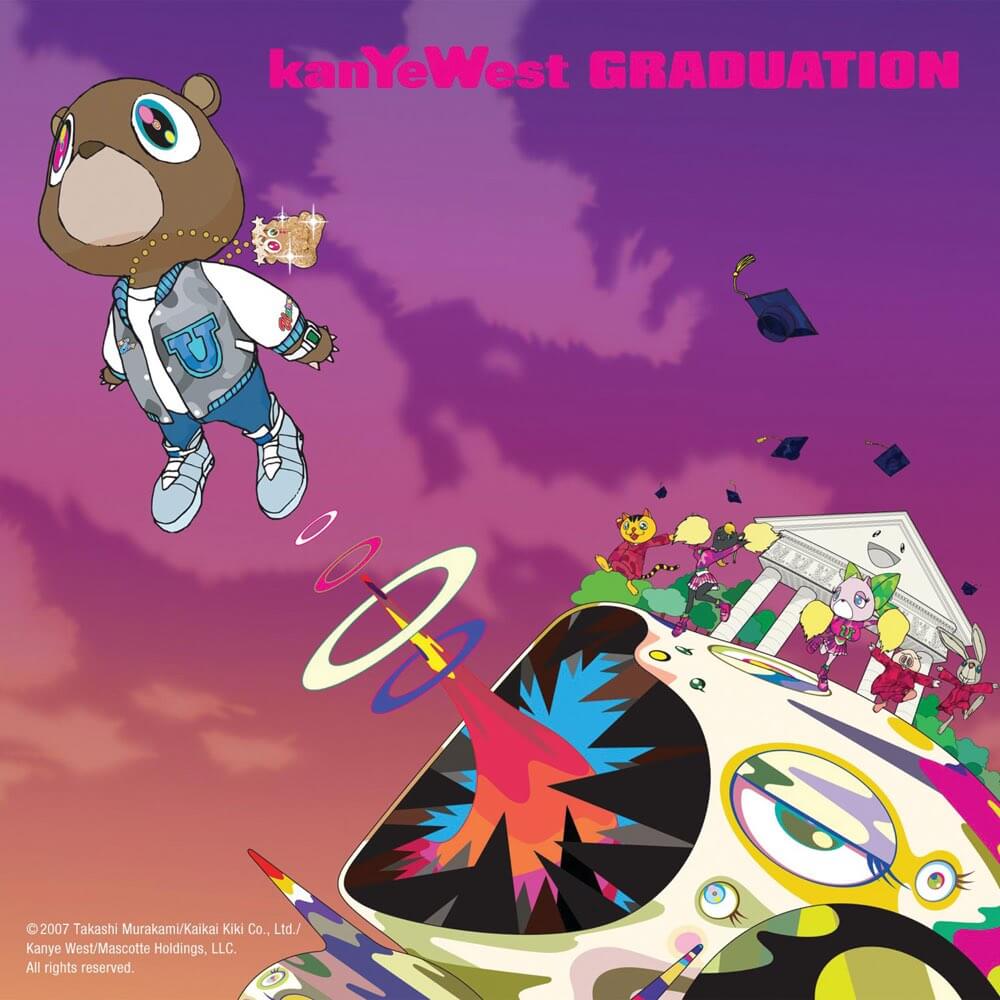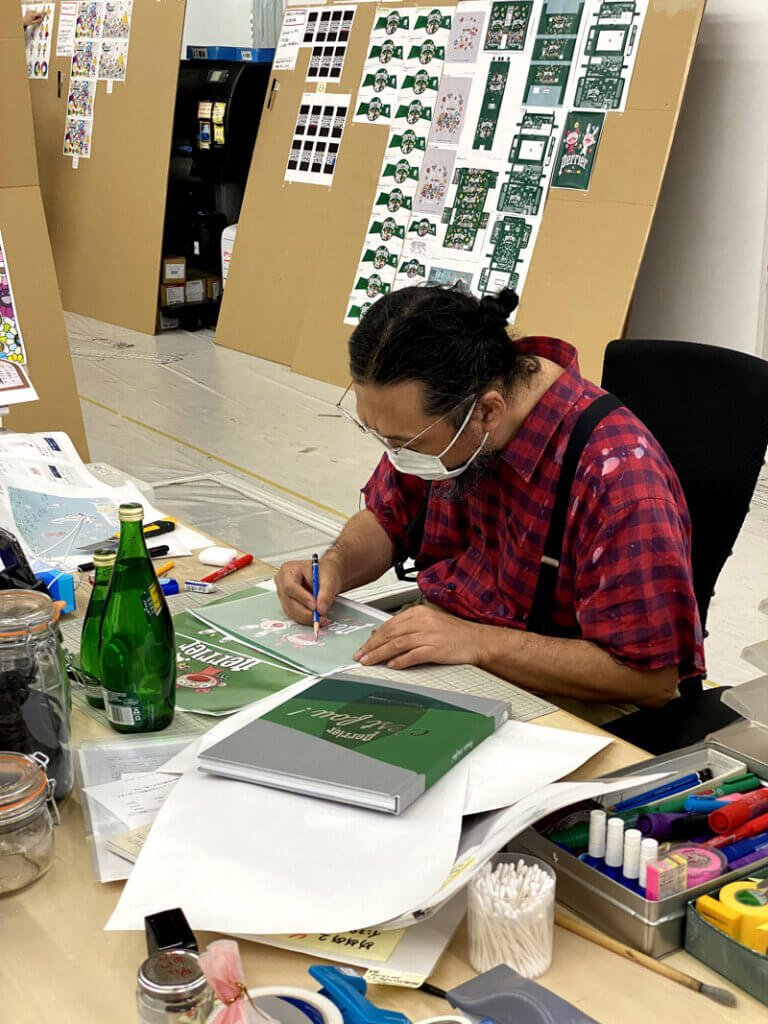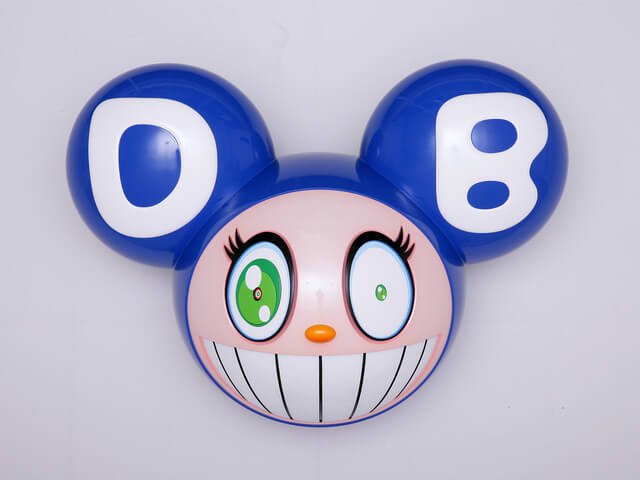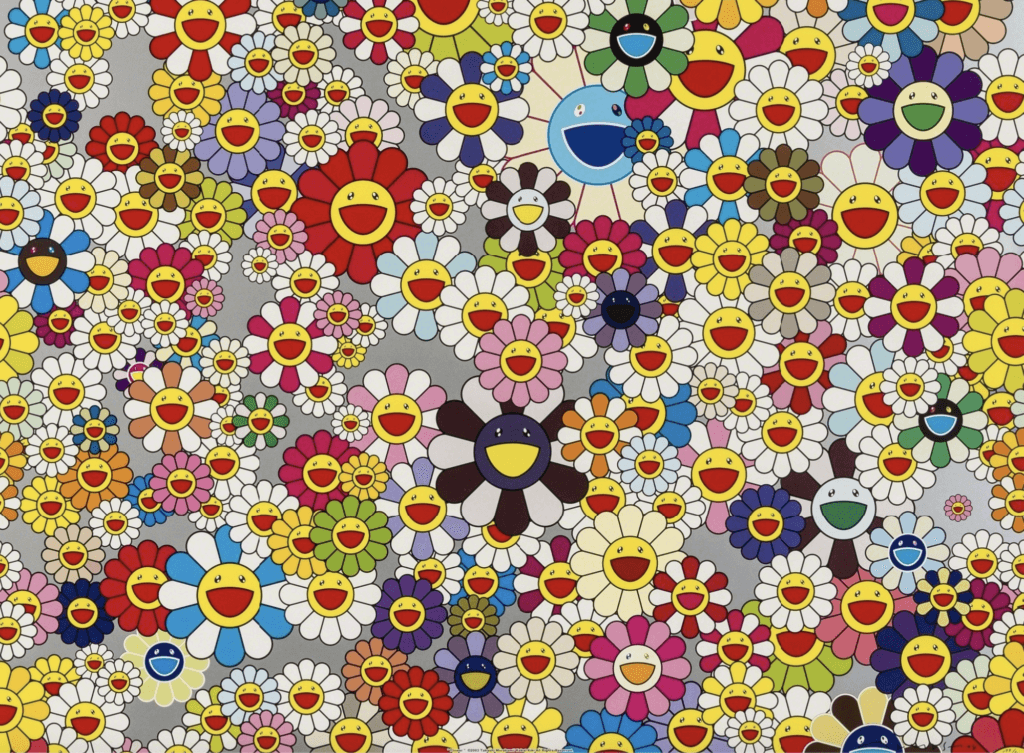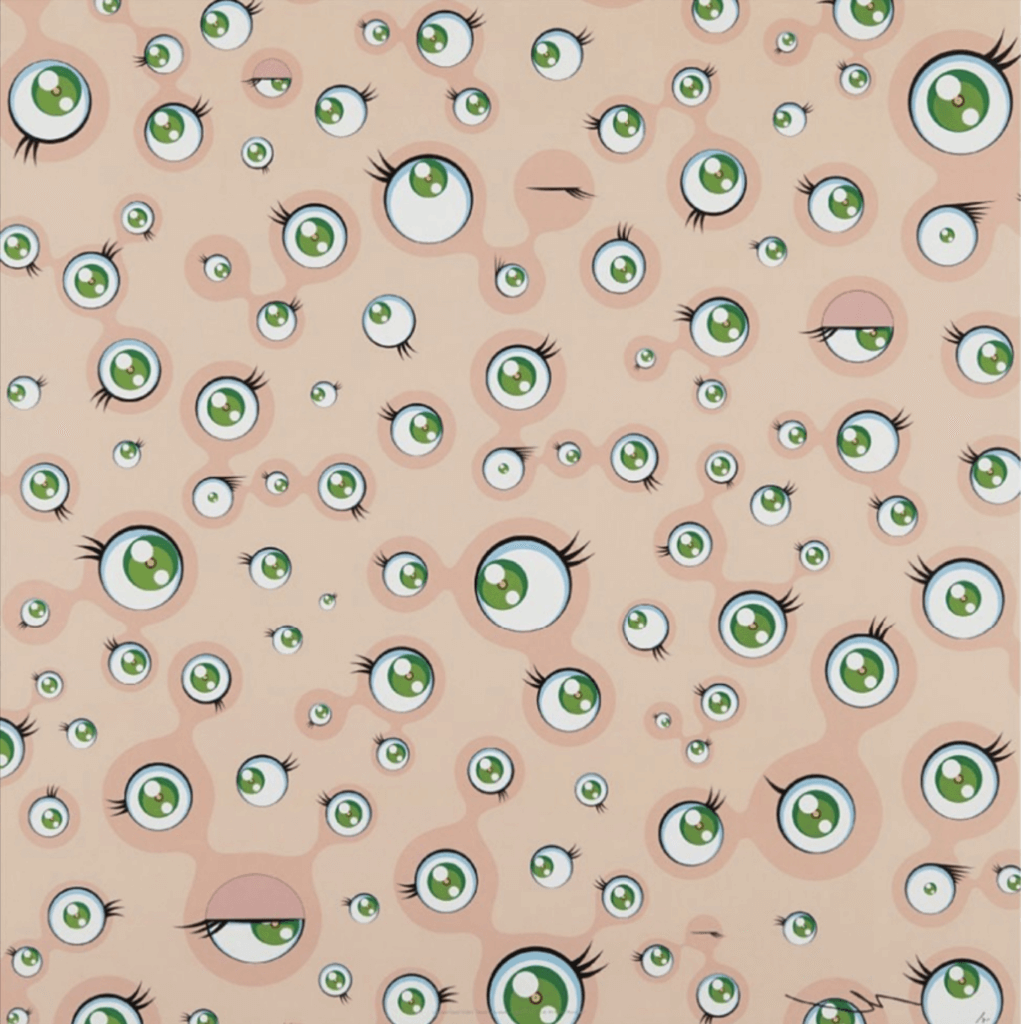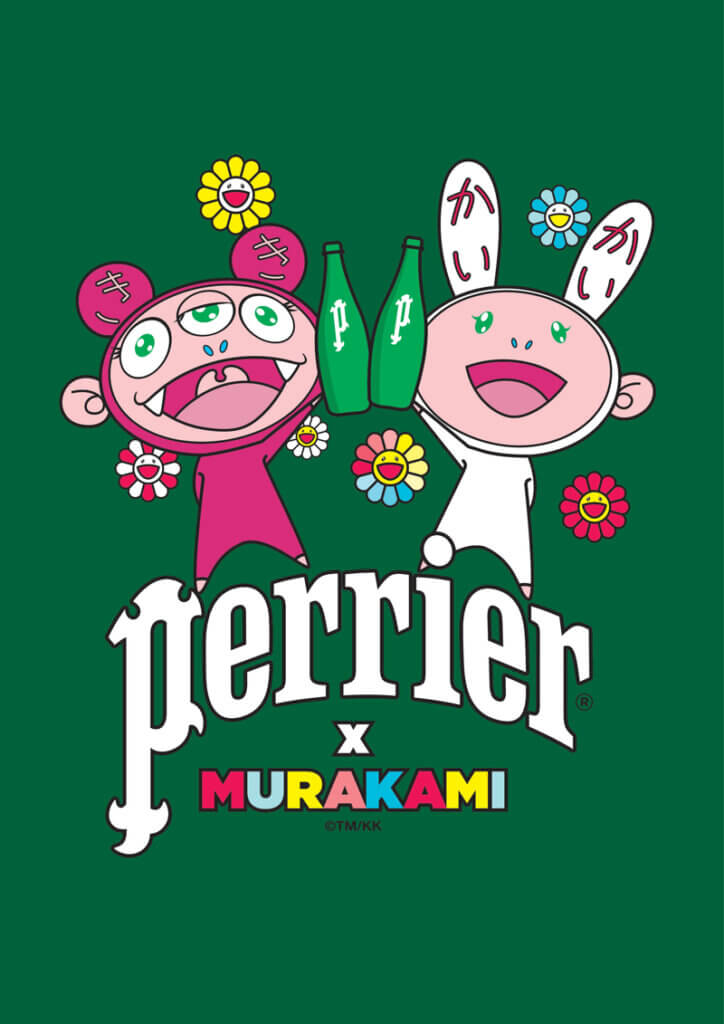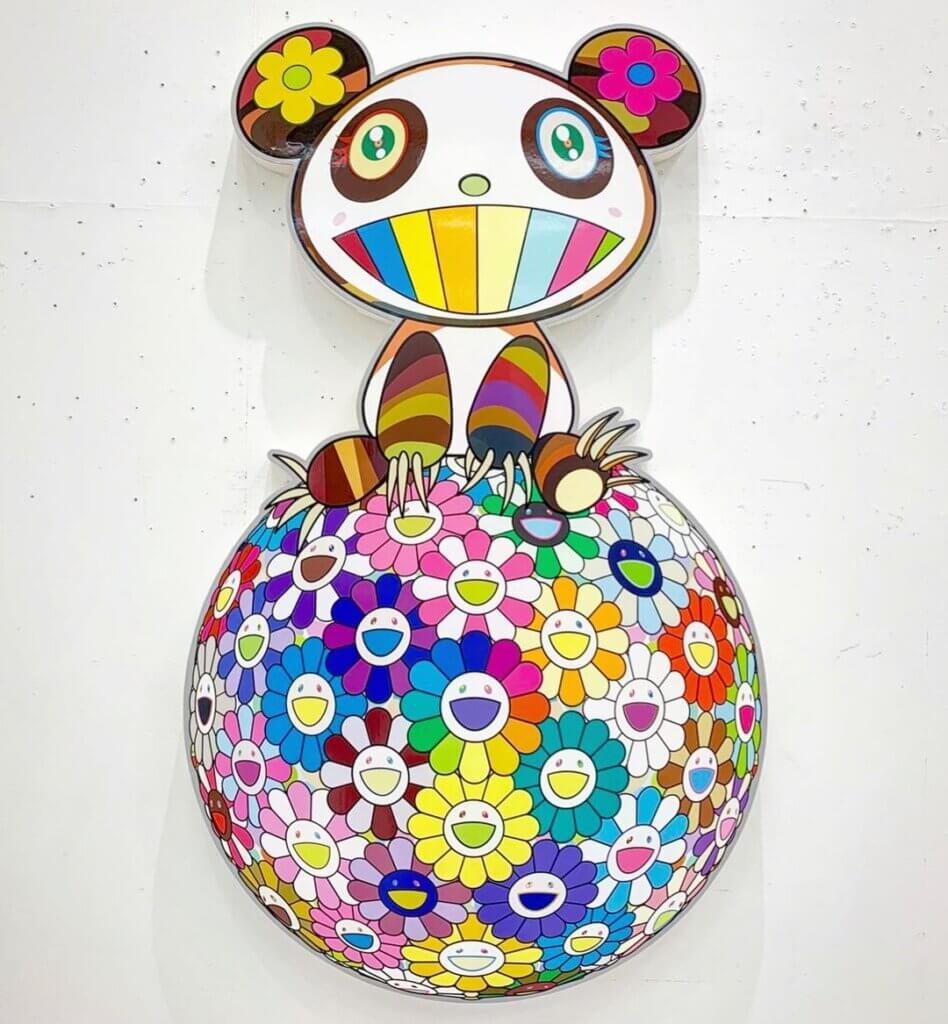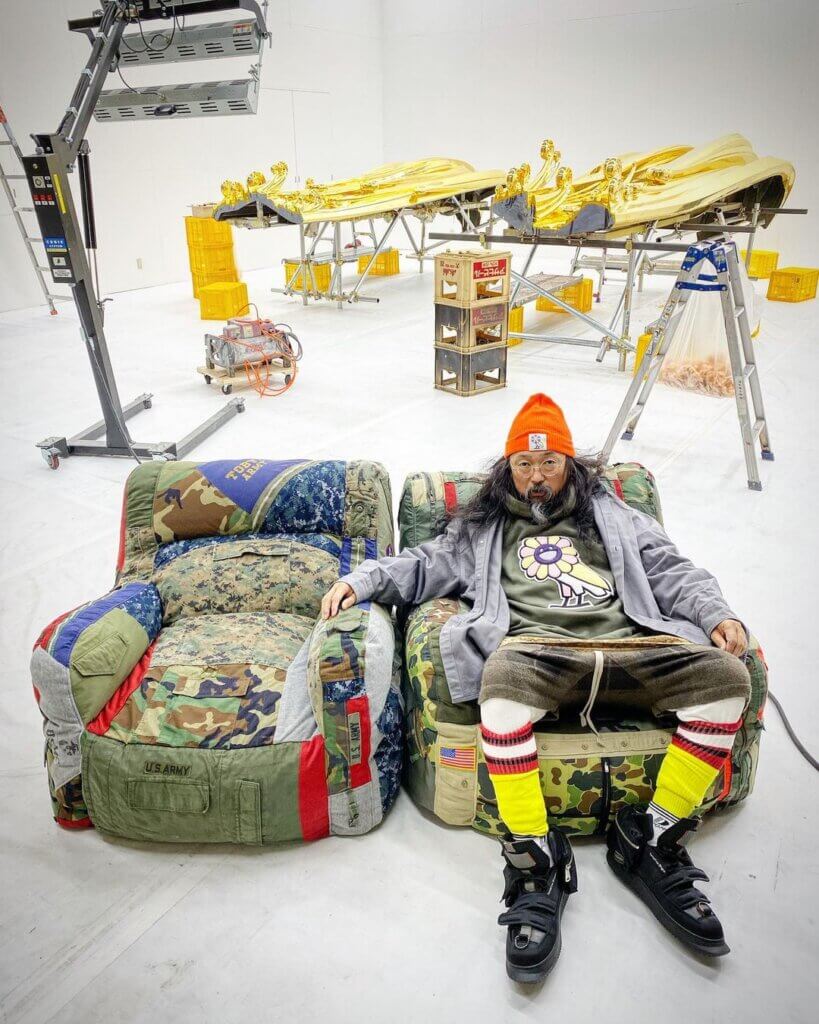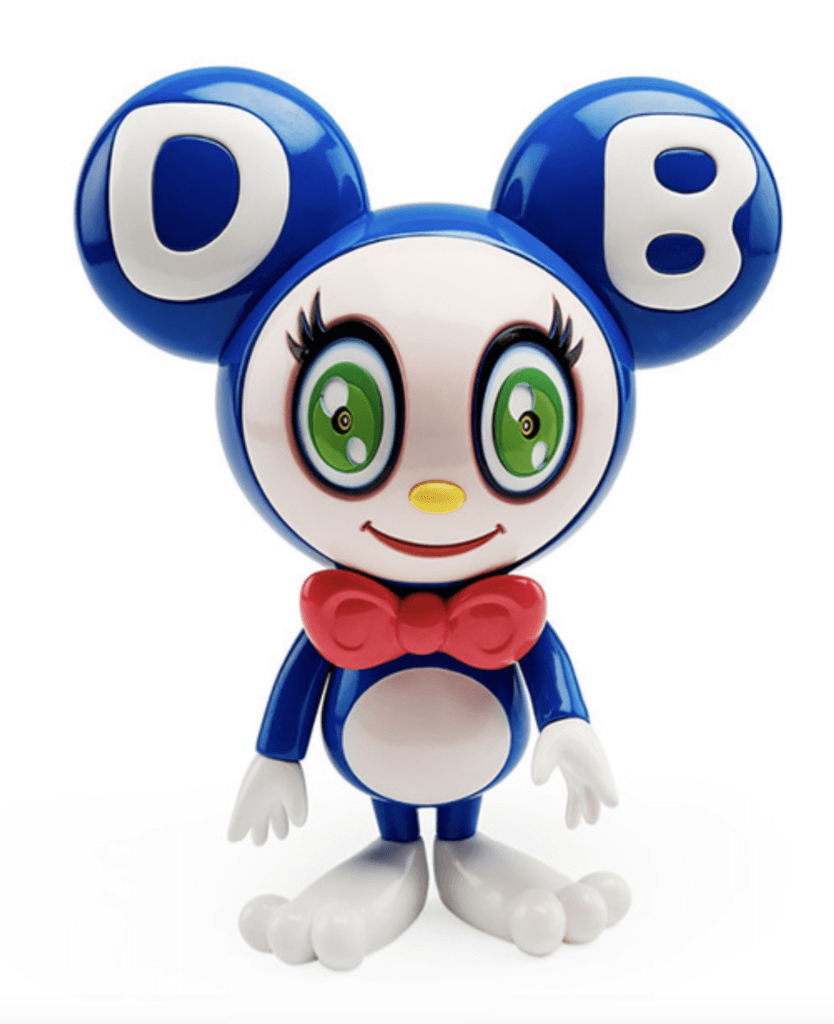Beyond question, Takashi Murakami is Japan’s most acclaimed living artist. Known for his fusion of fine art and Japanese pop culture. Mainly for his use of anime and Manga blurring the lines between art and consumerism, rising to fame in the mid-90s by spearheading “Superflat” a postmodern art movement and devising the entire artistic genre. The genre went on to become an international phenomenon infiltrating all areas of consumer culture from high to low art and putting him and Japanese art firmly on the map. Murakami expressions examine the prevalent tendencies of both Japanese and Western culture embellished in paintings, prints, sculptures and animations.
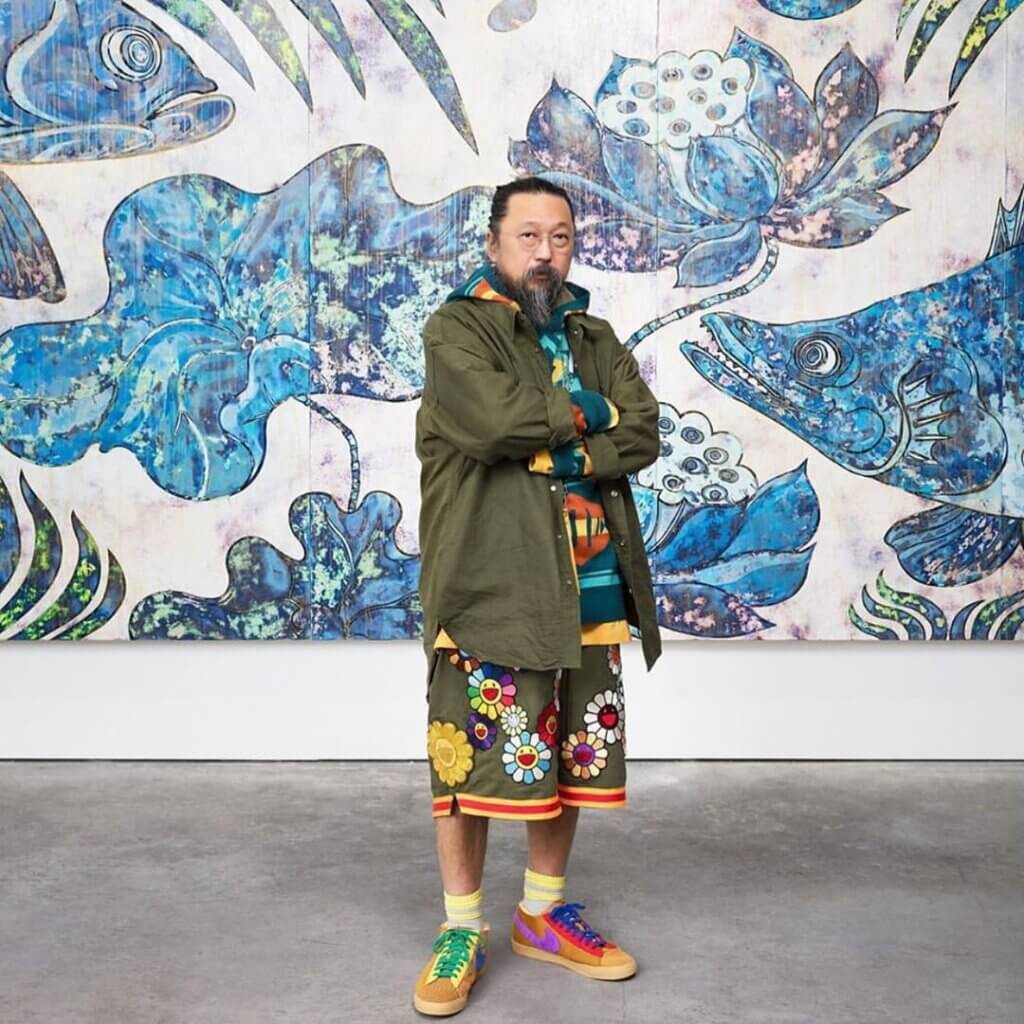
I basically live in my studio, having created an environment where I am immersed in the world of my artwork from the moment I wake up until I fall asleep.
Takashi Murakami
Depicting scenes of sexual fantasies, social commentary with an inherent essence of Japanese anime and a distinctive Manga aesthetic. Complemented in some works by euphoric psychedelic backdrops layered in floral motifs blossoming vibrant colours. Each one of his disciplines provides unique experiences feeding the appetites of the adorning aesthetes, as a result setting the record for contemporary Japanese art in 2002 with (Hiropon) a female anime-inspired figure expelling streams of breast milk from her nipples. Produced during his “bodily fluids” period (Hiropon) accumulated almost half a million US dollars at auction.
Following in the success of (Hiropon) Murakami companion piece titled (Lonesome Cowboy) a sculpture of a masturbating boy brandishing a lasso made of semen garnered $15.2 million. At the time of its sale made him one of the most expensive living artists in the world.
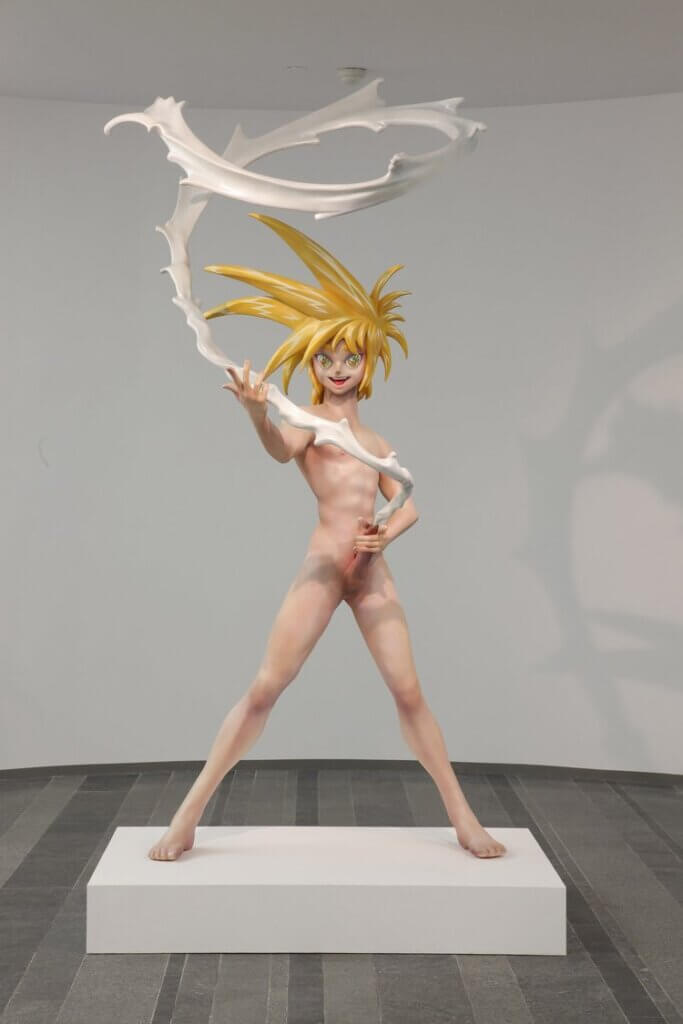
Credit Little Aesthete.
Establishing him and propelling his works further into the public eye attracting the attention of Louis Vuitton. In 2003 he reimagined the Louis Vuitton monogram in his intoxicating trademark rainbow brights. Which brought to life legendary collectable pieces for the brand. Sales of Vuitton’s leather goods in the first two years of their collaboration was in the vicinity of $300 million.
Murakami‘s creative genius continued by designing Kanye West’s “Dropout Bear” and West’s album cover for Graduation in 2007, accompanied by dipping West’s mascot right into the soul of his Superflat universe in the “Good Morning” music video the first track off the album.
Murakami is a dynamic artist and has collaborated with some of the worlds biggest brands and creative minds such as Issey Miyake, Supreme, Pharrell Williams, Virgil Abloh, Billie Eilish, PERRIER®, OVO and more. In recent years, he has diversified focus to working more on establishing Kaikai Kiki, a platform to cultivate and support the next generation of artists, as well as his endeavours in music and video. I had the pleasure of catching up with Takashi to speak with him about his creative practice, “Superflat”, the current state of the art world and his latest collaboration with PERRIER®.
Q: For those who don’t know you, can you please introduce yourself
TM: I’m a Japanese artist, age 58, who lives and works in Saitama Prefecture, which is next to Tokyo. As a student in the art university, I studied Nihonga, or traditional Japanese style painting. Although I mainly paint in the style of anime, the grammar of painting I use to construct my paintings are those of American Abstract Expressionism and Minimalism; as for techniques, I combine Nihonga techniques that emphasise the outlines with methods of painting on building walls, among others.
Q: What is your inspiration, and why do you do what you do?
TM: I am inspired the most when watching sci-fi films or TV animations, as well as when laughing at silly YouTube comedy shows. My motivation for doing what I do is that it puts food on my table—it’s my vocation.
Q: Can you tell us about your creative process?
TM: The process is directly connected to my lifestyle. That is, I basically live in my studio, having created an environment where I am immersed in the world of my artwork from the moment I wake up until I fall asleep. I may sit at my desk and work on running my company, resolving HR issues, and writing answers to interview questions like these.
And then, when I draw and paint, these things rush through my brain and trigger some inspiration or another. That’s the flash of inspiration, so to speak, but there’s no knowing when this flash would occur, so I have to torment myself in my studio, awaiting that moment.
I occasionally take vacations, but when I rest, my brain stops working, and I become dazed. If I’m off for a week, it takes a long time for me to recover the condition that allows for the flash again. And so I continue to live and work at my studio.
Q: What is the reason behind your fusion of manga, anime, fine art and pop culture in your works?
TM: Japanese people of my generation grew up reading manga and watching anime and special effect films, so these things are thickly in our flesh and blood. We can’t help expressing them. Those who are younger than me must have had different influences from ever-developing sources of entertainment, such as game, YouTube, social media, or VR, so I’m sure their ways of creative expression would be different than mine. In any case, the important thing in art is how you express your reality; it’s crucial to accurately depict the influences you have received in life through various methods and grammars of art.
Q: What inspired the term and art movement “Superflat”?
TM: When Japan lost the Pacific War in 1945, the United States drastically changed the course of Westernisation. Japan had been advancing since the Meiji Restoration of 1867, namely by imitating the Western social structure and aiming to become a prosperous country with a strong military. As a result, Japanese society became flat, with no clear pyramid structure, and this flatness permeated through all aspects of its culture. I called this social situation in Japan Superflat.
At the same time, in the creative realm, there is also a phenomenon suitable for the term Superflat in Japan. For example, in the Western theatre, such as the opera, sets and backdrops are used to forcefully create a quasi-three-dimensional space in order to imitate the reality on stage. In traditional theatre in Japan, on the other hand, space is created on a shallow stage with flat backdrops sliding laterally, with no interest in replicating the reality.
The audience is expected to be in on the pretence. I felt that there was so much flatness in Japan, be it a social situation or spacial design, and came up with Superflat as a catchphrase.
Q: Can you tell us how your interest in fashion became such a prominent part of your creative practice?
TM: An event called ComplexCon started in 2016, and I became involved at the invitation of Marc Ecko, the founder and the head of Complex Media at the time. He explained that it was a new, direct-to-consumer fashion trade show, but I couldn’t wrap my head around it. So I wondered who would attend such an event, and why I would be the appropriate ambassador (Host Committee) for it, but as Pharrell Williams was also involved in the same capacity, I thought it might be fun.
It was when I attended the event that I encountered street fashion. Not that the first encounter happened at ComplexCon—it was predetermined by the collaboration I had done years before with Kanye West.

The event’s audience already knew about me through the project. And the reason I ended up collaborating with Kanye, in turn, was probably because I had collaborated with Louis Vuitton. Going back further, Louis Vuitton came to know me through my solo exhibition held at the Cartier Foundation in Paris, and the Cartier Foundation discovered me through my collaboration with Issey Miyake. So the unbroken history went back all the way.
Even when I was in university, I was making and selling T-shirts, so I had always had something to do with the context of clothing. What triggered my final and unequivocal entry into the fashion world was my reconnection with Virgil Abloh, who used to be Kanye West’s assistant.
Q: You have collaborated with some of the greats of the creative world, which collaboration was your favourite and why?
TM: My collaboration with Louis Vuitton had the most significant impact of all. I communicated face to face with Louis Vuitton’s leadership at the time, including the late CEO Yves Carcelle and LV Japan’s Kyojiro Hata. When I got to roam around their headquarters, I witnessed the seriousness and earnestness of their staff and got a glimpse at the challenging reality of building a successful brand.
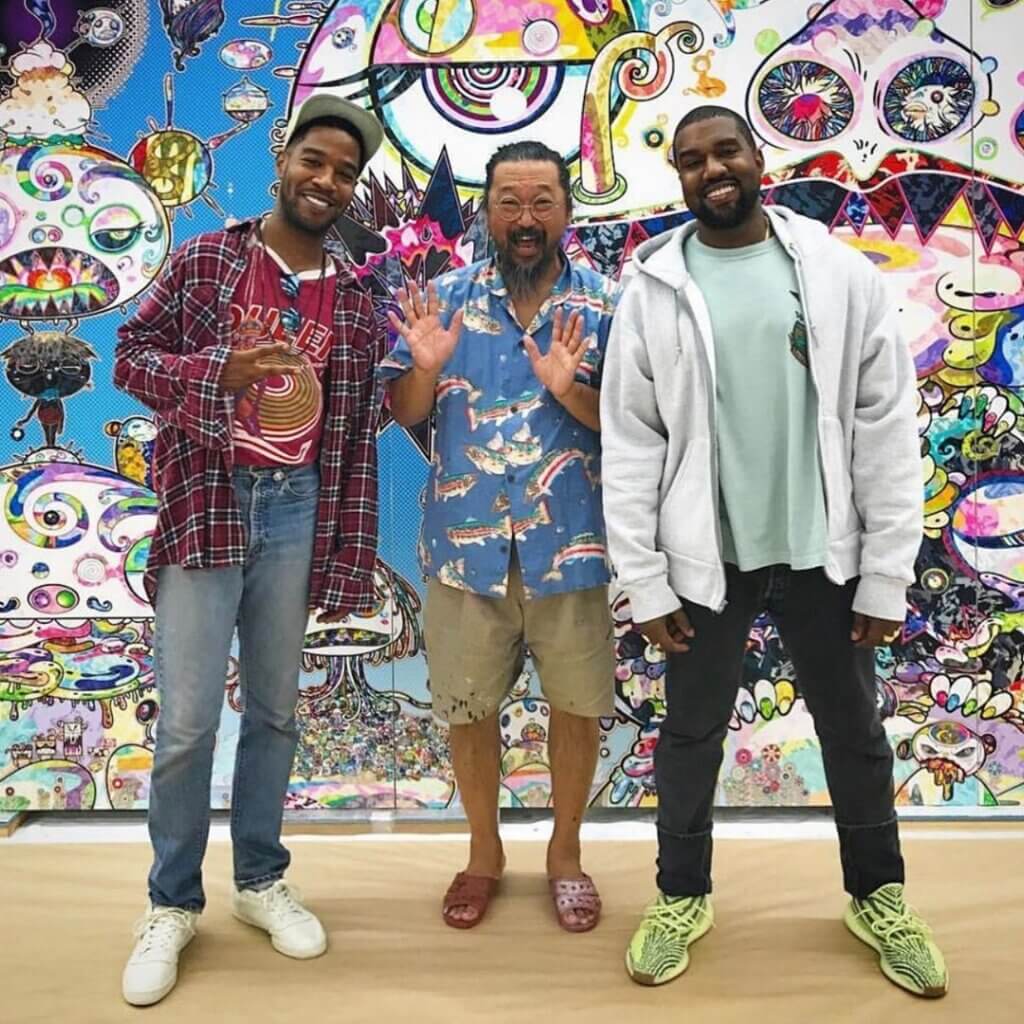
My subsequent dealings with Bernard Arnault and Delphine Arnault also had a massive impact on me. And again, my collaboration with Kanye West in a way determined the course of my life since, so I feel that it was a strange fate.
Q: How did the Perrier collaboration materialise, and why did you think Perrier water bottles were a suitable canvas for your expression?
TM: They approached me, and we discussed various conditions. They sent me a book on the history of their various collaborations with artists, and they were extremely courteous. So I felt that Perrier was a partner that I could run alongside to the finish line. I was thrilled that they printed my artwork on their bottles using a very unique technique. It’s wonderful to think that these items will remain in the world for a long time.
Q: Having exhibited across the globe, what was your most memorable exhibition?
TM: ©︎MURAKAMI at the LA MOCA. Before I became a contemporary artist, I felt awakened by the exhibition at the LA MOCA called Helter Skelter, curated by Paul Schimmel. The exhibition showcased the then unknown local artists from LA, including Paul McCarthy, Mike Kelly, and Robert Williams.
The way the art movement born out of the local climate was introduced was like a bolt out of the blue, and my work started to shift since then. So I was thrilled from the bottom of my heart to have Paul Schimmel curate my show. Through the show, I met the then director Jeremy Strick as well as Shin Kitahara, who used to be the museum’s staff and has since been working for my company. I think I managed to give more than my youthful 100% for that exhibition.
As part of the show, we had a functioning Louis Vuitton store open and operated inside the museum. Selling products, which was extremely controversial. Perhaps now, things may have become more complicated, what with the museum’s board approvals and how the non-profit organisations work, so I suspect it would be impossible to realise that project today.
But at the time, LA MOCA had grit of a sort, determined to do new things ahead of the rest of the world, so I was luckily able to have my way. It was an extraordinary exhibition.
Q: What do you think about the current state of the art world?
TM: In the past, when there was no Internet, we had to gather information from magazines. As a Japanese, I would try to get my hands on Artforum, ARTnews, Art in America, Parkett, and so on every month, and since I couldn’t read any English, would look at the images and imagined the state of the art world. Today’s art scene mainly revolves around social media, especially Instagram. On Instagram, Banksy has the most followers as an artist at 10,370,000. KAWS comes in second with 3,150,000 followers, and then myself, with 2,160,000 followers.
Communications on social media has become really important; Banksy had an exhibition in Japan this year, in 2020, and despite the pandemic, a vast number of people visited the show. Also, Banksy and KAWS both directly deal with auction houses, creating their own narratives through their involvements. Bansky, especially, shocked people by creating and selling a piece that auto-self-destructed by shredding.
I’m sure the auction house couldn’t have been uninformed. It was drastically new to orchestrate such a theatrical instance in the auction room, and that signified today’s art that feels real. Especially under the pandemic, we can’t all go to museums to directly experience art, so I myself have been trying various things out online.
Q: How has technology and innovation expanded the possibilities for your work in 3D and moving images?
TM: As technology advances, the space expands for the imagination to leap out to, pushing the territory for creativity wider, just like when an architect researches new building materials to develop and use, there can be so many innovations in Art through a similar process.
Q: What role does the artist have in society?
TM: An important job of an artist is to convey to the future audience after their death what the era they lived through was like, what the social situations were like, and what kinds of creative expressions existed. During their lifetime, there’s not much of a role for living artists other than to create work. The kind of narrative the works that are left behind would weave after the artist’s death is what’s crucial. I believe that an artist’s job is to influence the future, not their contemporaries.
Q: Which artists have caught your attention in the last five years?
TM: The genre called Toy Art or Junior Art. Art that’s not quite entirely Art or those that are toy-like is prevalent now. I named this genre myself. There was a precedent in the fashion scene. NIGO’s street fashion originated in Japan’s Uraharajuku fashion created by Hiroshi Fujiwara, NIGO, and jonio, and what was novel about this movement was that it rendered fashion toy-like.
It was fashion that melded foreign culture and Japan’s toy culture. Toy Art exists in this current, and I have actively created such works ever since the time of my debut. I made a lot of affordable items, as well as giveaways and toys.
Q: Lastly, what does Art mean to you?
TM: I probably have a dozen or so years left in my life. At most, I’ll live for 20 more years. But artwork can live on for much longer, for 100 or 200 years. So I hope to leave behind works that are fully packed with the present times for the future audiences to see.
This was Takashi Murakami to learn more or keep up with his work head over to his Instagram or website link below.
https://www.instagram.com/takashipom/
https://www.instagram.com/kaikaikikigallery/
©2020 ©︎MURAKAMI, Kaikai Kiki Co, Kanye West, Virgil Alboh, PERRIER®-x-MURAKAMI, ©LOUIS VUITTON, @TM_KK, LASH Music, LLC, MOCA


